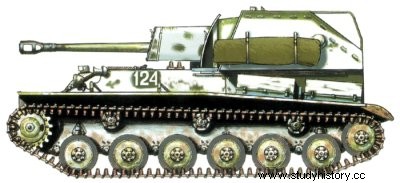
SU-76, SU-76M and variants
country USSR
Type: light self-propelled gun.
Crew: 4 men (gunner commander, outfitter, driver).
Armament :a 76.2 mm Model 1942 (215-3) gun.
Shielding: minimum 10mm; max 35mm.
Dimensions:
length (cannon included):5 m;
width: 2 74m:
height 2.20 m.
Weight in combat order :11.2t
Ground pressure :0.57 kg/cm2.
Mass power: 12.6 bhp.
Engine: 2 GAZ-202 6 cyl. water-cooled gasoline engines, each developing 71 hp at 3,400 rpm.
Performance:
road speed e:44 km/h;
autonomy: 265km:
vertical obstacle: 0.60 m;
clean cut: 2 m;
slope 280.
Service time :in the Red Army from 1943 until after the end of the Second World War.
Although still relatively modest, the Russian offensive operations of 1942 resulted in an acceleration of the Soviet advance. This situation highlighted the need to increase artillery mobility. Offensive units - infantry or armor - needed artillery support not only to break through enemy defenses but also for subsequent operations beyond their positions. The rate of production of tanks then reached by the Soviet industry made it possible to begin the parallel construction of self-propelled guns.
Factory Number 38, in particular, received the order to produce prototypes of a 76.2 mm semi-armoured light self-propelled gun, intended for the destruction of enemy armor. The chassis of the T-70 light tank was chosen and somewhat modified. in particular by the lengthening of its hull and its track system, equipped with six road wheels on each side. The adapted armament of the 76.2 mm Model 1942 (215-3) gun was created by General V. Grabin. Ammunition load was 60 shells.
Trials of the new self-propelled gun, then called SU-12, continued in the factory and in the field until the fall of 1942. In December, the high command authorized the adoption of the vehicle by the Red Army, under the name of SU-76. On the other hand, another model, the OSU-76, was rejected.
The production of the SU-76 began shortly afterwards at the factory Number 38. Like the prototype, the SU-76 of the first series had two engines, mounted on either side of the
vehicle, but later models.
they were mounted in tandem. After the vehicle arrived at the front, it was quickly realized that it was prone to breakdowns. Therefore, at the beginning of 1943, a team of engineers led by N. Astrov began the required modifications.
In May 1943, trials began on a new variant, called the SU-76M, which began mass production in June. As, at the same time, production of the original SU-76 had ceased, the SU-76M was simply called SU-76
In addition to the successive modifications made to the basic SU-76 vehicle, conducted numerous experiments aimed at creating other types of self-propelled guns based on its chassis. This is how the SU-768 model appeared in 1943, fully armored, but which never went beyond the prototype stage.
In 1944 was created the SU-74 model, fully armored, too. It was armed with the 57 mm Model 1943 (215-2) anti-tank gun. In 1945 the SU-85A and SU-858 prototypes appeared, both with an 85 mm gun and an improved chassis. None of these vehicles were standardized. The chassis of the SU-76 and SU-76M were used for the creation of the ZSU-37 single-barrel 37 mm self-propelled anti-aircraft gun, which was produced in limited quantities.
Initial production of the SU-76 began towards the end of 1942 at the Number 38 factory. Later, the GAZ and Number 37 factories also took part in production. Twenty-six SU-76s were built in 1942 and another 1,928 the following year (divided between the SU-76 and SU-76M models). In 1944, 7,155 SU-76M were built and in 1945, about 3,560. In total more than 12,600 self-propelled guns based on this chassis were produced during the Second World War.
